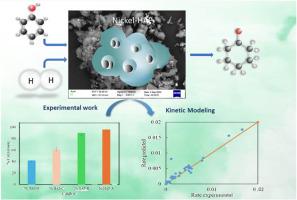Kinetic modeling of selective hydrogenation of phenol to cyclohexanone by using nickel hydroxyapatite catalyst
IF 3.4
4区 化学
Q2 CHEMISTRY, MULTIDISCIPLINARY
引用次数: 0
Abstract
The selective hydrogenation of phenol to cyclohexanone is a process of significant industrial relevance, serving as a key step in the production of important chemical intermediates. This study focuses on the preparation of Ni/HAP catalysts and evaluating various kinetic models for the hydrogenation of phenol to cyclohexanone. The catalyst was evaluated under optimized reaction conditions: 200 °C temperature, 30 bar hydrogen pressure, and a 10 % catalyst concentration. The uniqueness of this research lies in its comprehensive experimental and kinetic modeling approach, bridging a critical gap in the literature regarding the detailed kinetic behaviour of phenol hydrogenation using a Ni/HAP catalyst. Kinetic modeling was performed using three approaches: the rate law model, the Eley-Rideal (ER) model, and the Langmuir-Hinshelwood-Hougen-Watson (LHHW) model, each providing unique insights into the reaction mechanism and surface interactions. The kinetic assessment showed a competitive dissociative LHHW with 2-site adsorption model Ⅳ as the best model to describe this system. This work delivers an in-depth comparative analysis of kinetic models, thus enhancing the understanding of reaction pathways and facilitating the design of more efficient catalytic processes for industrial applications.

镍羟基磷灰石催化苯酚选择性加氢制环己酮的动力学模拟
苯酚选择性加氢制环己酮是一个具有重要工业意义的过程,是重要化工中间体生产的关键步骤。本文主要研究了Ni/HAP催化剂的制备,并对苯酚加氢制环己酮的各种动力学模型进行了评价。在最佳反应条件下对催化剂进行了评价:温度200℃,氢气压力30 bar,催化剂浓度10%。本研究的独特之处在于其全面的实验和动力学建模方法,填补了文献中关于使用Ni/HAP催化剂进行苯酚加氢的详细动力学行为的关键空白。动力学建模采用了三种方法:速率定律模型、Eley-Rideal (ER)模型和Langmuir-Hinshelwood-Hougen-Watson (LHHW)模型,每种方法都对反应机理和表面相互作用提供了独特的见解。动力学评价表明,竞争解离LHHW与2位吸附模型Ⅳ是描述该体系的最佳模型。这项工作提供了对动力学模型的深入比较分析,从而增强了对反应途径的理解,并促进了工业应用中更有效的催化过程的设计。
本文章由计算机程序翻译,如有差异,请以英文原文为准。
求助全文
约1分钟内获得全文
求助全文
来源期刊
CiteScore
3.50
自引率
7.70%
发文量
492
审稿时长
3-8 weeks
期刊介绍:
The Journal of the Indian Chemical Society publishes original, fundamental, theorical, experimental research work of highest quality in all areas of chemistry, biochemistry, medicinal chemistry, electrochemistry, agrochemistry, chemical engineering and technology, food chemistry, environmental chemistry, etc.

 求助内容:
求助内容: 应助结果提醒方式:
应助结果提醒方式:


